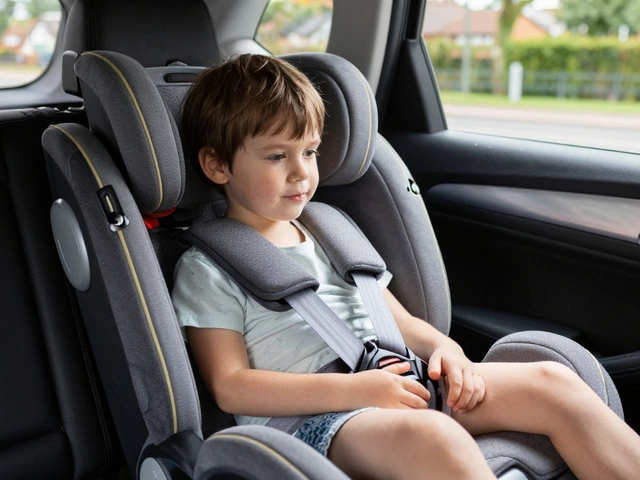
When it comes to car seats, most parents understand their importance in child safety but might not be aware that these essential devices have a lifespan. Unlike some household items that can be used indefinitely with care, car seats come with expiration dates that play a crucial role in keeping young passengers safe.
Understanding why car seats expire involves considering several factors, from the materials used to the technology advances in safety standards. While it might seem overwhelming at first, knowing these details can help parents make informed decisions about selecting, using, and eventually replacing a car seat.
- Introduction to Car Seat Expiration
- Understanding the Expiration Date
- Reasons Behind Car Seat Expiration
- Signs It’s Time to Replace a Car Seat
- Tips for Prolonging Car Seat Life
- Safety Tips for Parents
Introduction to Car Seat Expiration
Every parent knows that ensuring a child's safety is paramount, yet not everyone realizes that car seats, those essential safety devices, have expiration dates. It's an easy oversight; after all, how often do we think of child safety equipment like we do food or medications? But the reality is, car seats are meticulously designed with expiration dates to ensure they provide the same level of protection as when they were first used. Over time, the materials, which can include hard plastics and soft cushioning, degrade. This degradation can compromise the seat's ability to perform during a collision, thus putting your child at risk if these guidelines are ignored. As technology advances and safety standards improve, manufacturers constantly update materials and design, necessitating changes in how long a seat remains effective.
Some might wonder why car seats can't just keep working if they appear physically intact. It's a fair question and one that highlights a common misconception. The truth is, many elements that determine a car seat's effectiveness are not visible to the naked eye. Think about a car seat left in a vehicle, exposed to the sun's harsh UV rays and changes in temperature. These environmental factors slowly weaken the plastic and fabric, not to mention possible stress from regular use. Debris, spills, and even regular cleaning can contribute to the gradual wear and tear. According to experts at the American Academy of Pediatrics, 'Using a car seat beyond its expiration date significantly increases the risk of injury.' So, it’s crucial not only to check the expiration but also to understand the reasons behind it.
There’s an underappreciated flip side, though: newer car seats mean upgraded technology and advanced safety features. It's an ongoing process, driven by rigorous testing and research. As crash-test standards evolve, so do the methods and technology embedded in car seats. This progression is why many manufacturers suggest replacing a car seat every six to ten years. It's not just about material degradation; it's about offering the best possible protection based on the latest scientific understanding.
Knowing all this, parents should feel empowered, not overwhelmed. Consider making a calendar reminder to check your car seat’s expiration date alongside birthday or vacation planning. Many car seats come with a label indicating the expiry, or it's stamped into the plastic base. Above all, we must treat car seat replacement as a necessary step in the journey of parenthood, one that's as vital as making sure there's enough milk and diapers at home.
Understanding the Expiration Date
Car seats might look sturdy and permanent, but like other safety equipment, they have a limited life span. This might surprise some parents who wonder why an object crafted from hard plastic and strong materials would need to be replaced. The expiration date, typically found on the car seat label or in the instruction manual, is more than just a manufacturer's suggestion; it reflects the fact that car seats undergo wear and tear over time. Exposure to sunlight, temperature fluctuations, and just regular use can degrade the materials these seats are made of, potentially compromising their effectiveness in an accident.
Plastic, the primary material in most car seats, can lose strength as it ages, becoming brittle and less able to withstand the forces of a collision. Add in the straps, buckles, and other components, which also degrade, and the picture becomes clearer: a car seat is designed to protect during the most unpredictable moments of travel, but it’s only effective when in optimal condition. As technology advances, safety standards evolve too, introducing improved features that often render older models obsolete. These improvements are a good reason to stay updated with car seat models that align with the latest safety innovations.
According to the National Highway Traffic Safety Administration (NHTSA), 'Car seats have expiration dates because the components, including plastics and hardware, may weaken over time.'
Some might think the idea of expired car seats is simply a marketing strategy to sell more products, yet research shows that car seat materials can indeed fail after prolonged use. For instance, a 2015 study by Safe Traffic System, Inc. highlighted how sunlight can weaken the structural integrity of car seat materials. They found that after just a few years, plastic can degrade significantly, leading to potentially dangerous failures.
Given all this, it’s crucial for parents to pay close attention to the expiration dates on their child's car seat. While it might seem like an inconvenience to replace a seemingly good seat, the benefits of ensuring maximum protection for your child far outweigh the discomfort of spending on a new one. Many manufacturers place the expiration date on a sticker located on the bottom or side of the seat. Failing to check this could result in using a seat that no longer offers the safety it once did.
| Common Factors Leading to Expiration | Impact on Car Seat |
|---|---|
| Exposure to Elements | Material Degradation |
| Technological Advancements | Outdated Safety Features |
| General Wear and Tear | Weakening of Components |
Parents should embrace the reality that these expiration dates are set with their child's safety in mind. It's about ensuring that when you embark on a journey, be it short or long, you do so with the peace of mind that comes from providing the best safety measures for your little ones.

Reasons Behind Car Seat Expiration
Car seats, much like many safety devices we rely on, have an expiration date set to ensure they perform optimally during their critical function, which is protecting your child in the event of an accident. One of the main reasons car seats expire is due to material degradation. Over time, the materials used in car seats such as plastics and fabrics begin to break down. Plastic can become brittle and less strong, which might not provide the proper level of protection and support your child needs. Factors like extreme temperatures in cars, exposure to sunlight, and general wear and tear can accelerate this process. This degradation is similar to how other materials get weakened due to consistent use and environmental exposure.
Another significant factor is the advancement in safety technology. Safety standards and laws are continually updated based on the latest research and crash test data. Newer car seats are often designed to meet these evolved standards, which means that an expired car seat might not provide the same level of safety features as a newer model. Car manufacturers are constantly innovating, introducing better harness systems, side-impact protection, and energy-absorbing foam that weren’t available just a few years ago. As technology advances, so does the importance of having a seat that aligns with the latest safety measures.
Changes in regulations also play a part in why car seats come with an expiration date. Organizations such as the National Highway Traffic Safety Administration (NHTSA) and American Academy of Pediatrics review their guidelines and recommendations periodically, which can lead to updates in what’s considered safe and effective in car seat designs and installation methods. These changes ensure that all children have the best possible protection. Having an expired seat might mean missing out on important safety improvements that could make a difference in preventing or reducing injuries.
Furthermore, manufacturers continue to gather data and feedback from past incidents and consumer reports, guiding them in refining car seat designs constantly. According to the NHTSA, "Every eleven seconds, a car accident occurs in the United States, highlighting the urgency of keeping your car seat up to date with these protective evolutions."
Indeed, according to Dr. Sarah Haverly, an expert in child safety at a leading crash analysis firm, "Each element of a child's car seat is designed with precision to weather an impactful scenario, and any compromise due to age can be pivotal."
Wear and tear also significantly affect the integrity of a car seat. Even if you meticulously maintain the seat, the repeated use over the years, including installation and removal from vehicles, can cause important parts to weaken or not fit as securely as they should. Buckles, straps, and harnesses might not work as intended when a seat is used past its lifespan. Parents might not notice the gradual decline in performance, but during a crash, these components failing could lead to severe injury.
To help users, many manufacturers place the expiration date on the back or bottom of the car seat. It is vital for parents and guardians to check this date when purchasing, using, or receiving a car seat secondhand. By ensuring the car seat is within its recommended lifespan, you can trust it to do its job when it's needed most. These reasons collectively highlight the crucial need to heed expiration guidelines for car seats, affirming that your child's safety is never compromised by using outdated safety gear.
Signs It’s Time to Replace a Car Seat
Knowing when to replace a car seat is crucial for the safety of your child. While the expiration date is a clear indicator, other signs can also suggest it's time for a change. Everyday wear and tear can take a toll over the years, potentially affecting the car seat's performance in the event of an accident. If you notice cracks in the plastic shell or the metal parts are rusting, it's a clear sign to stop using it. The padding and harness can also deteriorate over time, which can compromise the effectiveness of the seat in protecting your child.
An often overlooked factor is the car seat's history. If a seat has been involved in a moderate to severe crash, it needs to be replaced immediately, even if damage isn't visible. The forces exerted during an accident can cause hidden damage that affects the seat's integrity. Even minor accidents should prompt a thorough inspection. Check your car seat manufacturer’s guidelines, as they will specify when to replace the car seat after a crash. Additionally, missing parts, such as harness clips or pieces of the base, mean the seat is far less safe. Attempting to replace these with non-original parts is not advisable, as it can seriously compromise the safety features the manufacturer designed.
"A car seat is part of your child's life-saving gear, and like all safety equipment, it must be maintained and replaced as necessary," states the American Academy of Pediatrics.
Accessibility to newer technology should also be a reason to consider upgrading your car seat. Over the years, safety standards improve, offering better protection and ease of use. If your seat is several years old, it might lack features like side-impact protection or advanced energy-absorbing materials now common in newer models.
For parents who are short on knowledge, checking the National Highway Traffic Safety Administration (NHTSA) website can be enlightening. They not only offer ratings on car seat safety but also provide insights into new technologies and features. Features like the LATCH system, which stands for Lower Anchors and Tethers for Children, are crucial, as they offer more straightforward and secure installation. If your car seat does not have these modern anchoring systems, it might be worth considering an upgrade.
Finally, let's not forget the emotional factor involved. Often, keeping a child’s car seat might be sentimental, especially when it's your firstborn's. While it's okay to be attached, putting safety first is always the best decision. If you're unsure whether your car seat is still safe, consulting with a safety expert or a certified Child Passenger Safety Technician can provide the reassurance you need.

Tips for Prolonging Car Seat Life
Caring for a car seat properly can significantly extend its lifespan and ensure it remains safe for your child as long as possible. One of the most effective ways to prolong the life of a car seat is by diligently following the manufacturer's care instructions. It may sound simple, yet you'd be surprised how many folks skip this crucial step. By taking a few extra moments to read and adhere to these guidelines, you protect the integrity of the materials and parts.
Another important aspect to consider involves cleaning the seat. While it's tempting to throw the cover in the washing machine, it's best to check the labels first. Harsh detergents and hot water can weaken fabrics and straps, while some plastics don't fare well with high temperatures. Opt for gentle, hand-clean methods using mild soap and air drying. This attentive care not only maintains the car seat’s appearance but also guards against the gradual deterioration of its components.
Storing the car seat properly when not in use is another key to longevity. If you're storing it away for future use or swapping it between vehicles, keep it in a cool, dry place. Avoid leaving it in environments that experience extremes in temperature, like a hot attic or a damp basement. Temperature swings can cause plastics to become brittle over time or fabrics to develop mold. By carefully managing where you store car seats, you help ensure their structural integrity remains intact.
- Check for recalls regularly to make sure the car seat is up to the latest safety standards.
- Replace parts with manufacturer-approved components only to avoid compromising safety.
- Avoid buying second-hand car seats as past use and damage may not always be visible.
Moreover, be mindful of how often the car seat undergoes transfers between different cars. Each time you adjust and re-fit the seat, it undergoes wear and tear. While car seats are designed to be portable, minimizing unnecessary moves can enhance their lifespan.
"Frequent adjustments over time can create friction that might weaken certain components," remarked a spokesperson from a leading car seat manufacturer.Adjustments are inevitable with growing children, but keep them within reason to prevent unnecessary strain on the seat components.
Finally, routinely check the seat’s components to address any minor issues before they escalate. This includes the buckle, harness, and seat shell. Spot any cracks, fraying or wear early, and consult the manufacturer if replacements are needed. Regular checks ensure safe use and help maintain the seat in its best condition, ensuring your child's safety in every ride.
Safety Tips for Parents
Ensuring the safety of young passengers is a priority for every parent, and knowing the ins and outs of car seats is a big part of that responsibility. Luckily, there are several straightforward steps you can follow to make sure your child is as safe as possible whenever they’re on the road. First and foremost, it’s crucial to understand that not all car seats fit in all cars. Before purchasing a car seat, confirm that it is compatible with your vehicle. You can do this by consulting the vehicle’s owner manual, which often provides details on the types of car seats suitable for the model. Once a seat is purchased, reading the manual provided by the seat manufacturer is another vital step. These manuals include comprehensive instructions that ensure the seat is installed correctly.
Moreover, proper installation of the car seat can be a challenging task. Car seats often incorporate specific design elements meant to secure the seat firmly within the vehicle. Many communities offer assistance through programs or services where trained technicians can check your seat’s installation, ensuring it is secure and up to standard. Regularly checking your child’s car seat height and weight recommendations is also vital. Children grow quickly, and a car seat should fit them snugly without being overly tight. Always make sure to adjust the harness and straps so that they properly accommodate your child’s current size.
Another essential safety tip is to regularly check the expiration date of the car seat. Just like food products, car seats have a lifespan, usually ranging from six to ten years. This time bracket ensures that the materials remain durable and that the seat complies with the latest safety regulations. As an added layer of protection, some parents find peace of mind in keeping a record of their car seats' serial numbers. This can be useful for tracking any recall notices or safety alerts that might be released. It is worth noting that approximately 46% of car seats are used incorrectly, underscoring the importance of staying informed and vigilant.
The National Highway Traffic Safety Administration (NHTSA) emphasizes that 'using the right car seat every time your child is in the car is one of the simplest and most effective ways to keep them safe.' This underscores the simple truth that proactive safety measures can make all the difference.
Finally, maintaining the cleanliness and condition of the car seat is another key to ensuring it's at its best when you need it. Check the seat regularly for any wear and tear, especially in the straps and buckle systems, and clean it as recommended by the manufacturer. Remember, excessive sun exposure can weaken the plastic components over time, so when not in use, keeping it out of direct sunlight can prolong its lifespan. These combined efforts in understanding and utilizing your car seat not only help safeguard your little one but also provide peace of mind while traveling.






